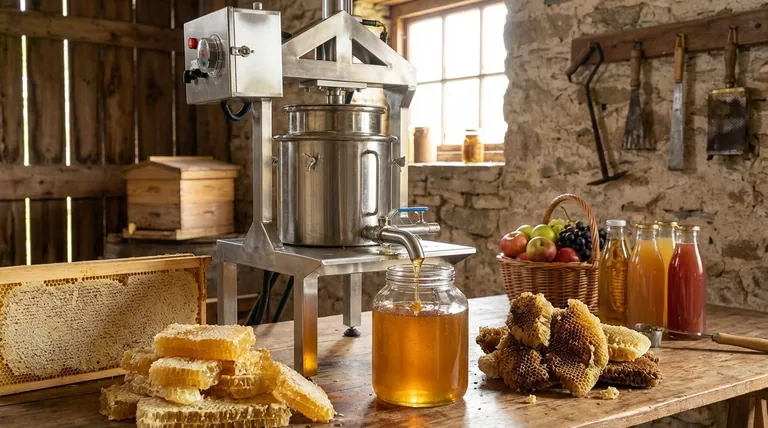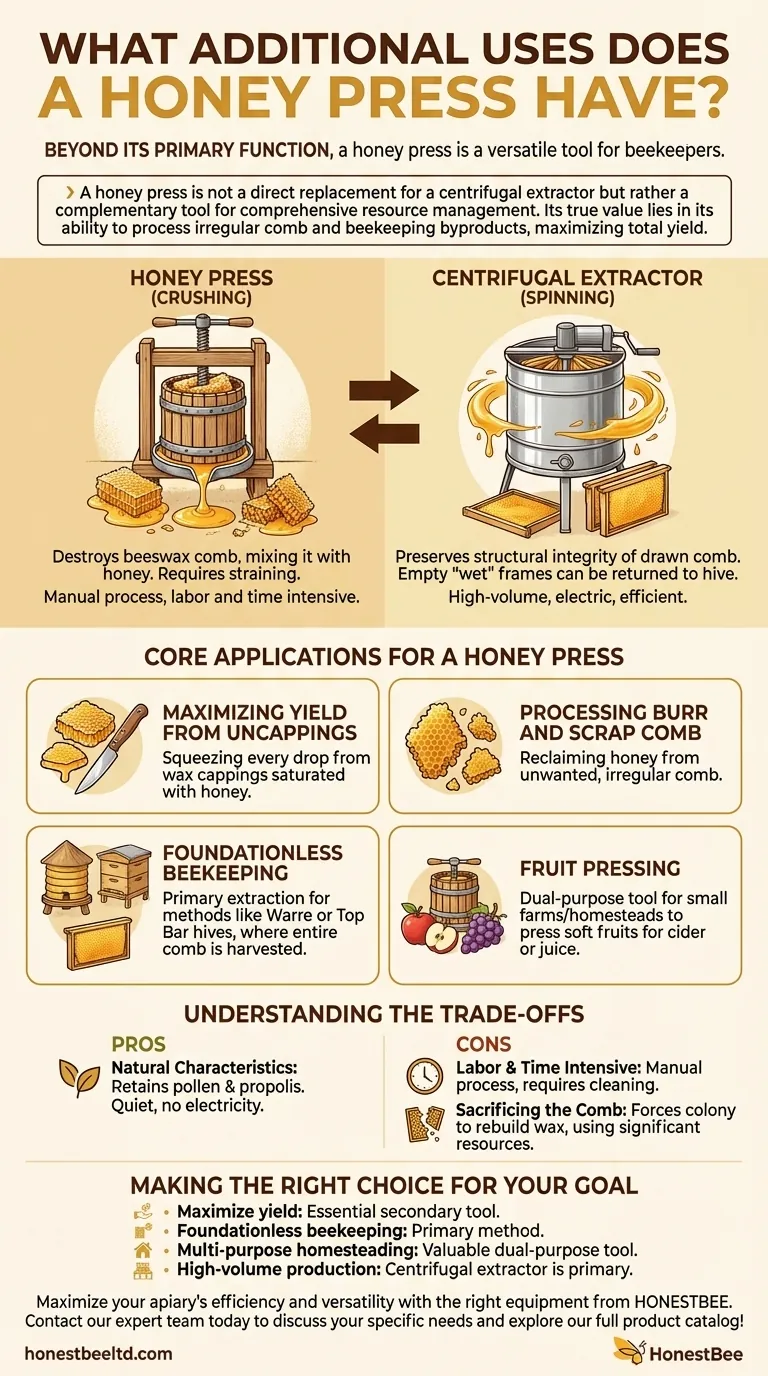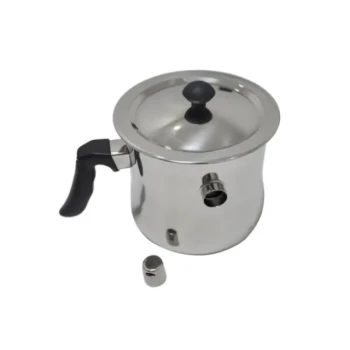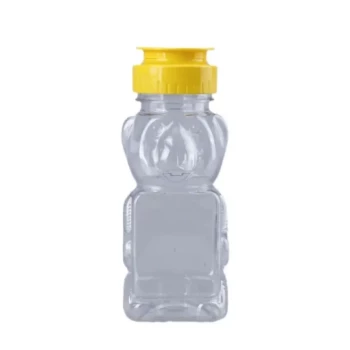Beyond its primary function, a honey press is a remarkably versatile tool for any beekeeper looking to maximize their harvest and reduce waste. It excels at extracting honey from materials that a standard centrifugal extractor cannot handle, such as wax uncappings and irregular burr comb. For some beekeeping methods and even other homesteading tasks, it is an indispensable piece of equipment.
A honey press is not a direct replacement for a centrifugal extractor but rather a complementary tool for comprehensive resource management. Its true value lies in its ability to process irregular comb and beekeeping byproducts, maximizing total yield and serving specialized beekeeping philosophies.

The Fundamental Difference: Pressing vs. Spinning
To understand the unique uses of a honey press, it's crucial to distinguish it from the more common centrifugal extractor. They operate on entirely different principles and serve different priorities.
How a Honey Press Works (Crushing)
A honey press, sometimes called a comb crusher, works by applying mechanical pressure. You place raw honeycomb into a perforated basket and turn a screw mechanism, which compresses the comb and squeezes the honey out.
This process destroys the beeswax comb, mixing it with the honey. The honey is then typically strained to separate it from the wax particles.
How a Centrifugal Extractor Works (Spinning)
A centrifugal extractor uses rotational force to sling honey out of the comb. Uncapped frames are placed inside a drum, which then spins at high speed.
This method preserves the structural integrity of the drawn comb. Beekeepers can then return these empty "wet" frames to the hive, giving the bees a massive head start on the next honey flow.
Core Applications for a Honey Press
Because it destroys the comb, a honey press is the perfect solution for any situation where preserving the comb is either impossible or not a priority.
Maximizing Yield from Uncappings
When you prepare frames for a centrifugal extractor, you must first slice off the top layer of wax that seals the honey cells. This material, called uncappings, is saturated with a significant amount of honey.
A honey press is the ideal tool for squeezing every last drop of valuable honey from these wax cappings, which would otherwise be difficult to process.
Processing Burr and Scrap Comb
Bees often build irregular or "burr" comb in undesirable places, which cannot be placed in a standard extractor. A press allows you to reclaim the honey from this scrap comb instead of wasting it.
A Key Tool for Foundationless Beekeeping
Beekeeping methods that do not use pre-made foundations, such as in Warre hives or Top Bar hives, rely on harvesting the entire comb. Since the comb will not be reused, a press is the primary and most logical extraction method for these styles of beekeeping.
A Versatile Non-Beekeeping Use: Fruit Pressing
Many small-scale honey presses are structurally identical to fruit presses. This dual-purpose capability makes the press a valuable tool for a small farm or homestead, allowing you to press apples for cider, grapes for juice, or other soft fruits.
Understanding the Trade-offs
A honey press offers unique benefits, but it's essential to understand its limitations to determine if it's the right tool for you.
Pro: Natural Characteristics
Some beekeepers believe that pressing honey, as opposed to spinning it, retains more of the natural pollen and propolis within the final product. The process is also quiet and requires no electricity.
Con: Labor and Time Intensive
Using a press is a manual process. It involves crushing the comb, loading the press basket, slowly applying pressure, and requires a thorough cleaning with warm water after each use. For large harvests, this can be significantly more time-consuming than using an extractor.
Con: Sacrificing the Comb
This is the most significant trade-off. Bees expend enormous energy and consume large amounts of nectar (estimated at 6-8 pounds of honey) to produce just one pound of beeswax. By destroying the comb, you are forcing the colony to spend its resources rebuilding wax instead of gathering more nectar.
Making the Right Choice for Your Goal
Ultimately, the decision to use a honey press depends entirely on your beekeeping philosophy, equipment, and goals.
- If your primary focus is maximizing honey yield from all sources: A press is an essential secondary tool for processing uncappings and scrap comb alongside a primary extractor.
- If you practice foundationless beekeeping (e.g., Warre hives): A press is your primary and most logical extraction method.
- If you want a multi-purpose tool for a small homestead: A press's ability to also process fruit makes it a highly valuable and versatile investment.
- If your priority is high-volume production and preserving drawn comb: A centrifugal extractor should remain your main tool, as a press destroys the bees' hard work.
Understanding these applications and trade-offs empowers you to choose the extraction method that best aligns with your operational goals.
Summary Table:
| Application | Key Benefit | Ideal For |
|---|---|---|
| Processing Uncappings | Maximizes honey yield from wax cappings | Beekeepers using centrifugal extractors |
| Extracting from Burr/Scrap Comb | Reclaims honey from irregular comb | All beekeepers to reduce waste |
| Foundationless Beekeeping | Primary extraction method for entire comb harvest | Warre hive, Top Bar hive beekeepers |
| Fruit Pressing | Multi-purpose tool for cider/juice making | Small-scale farms and homesteads |
Maximize your apiary's efficiency and versatility with the right equipment from HONESTBEE. Whether you're a commercial apiary or a beekeeping equipment distributor, our wholesale-focused operations provide the durable, high-performance tools you need—from honey presses to centrifugal extractors. Let us help you optimize your harvest and reduce waste. Contact our expert team today to discuss your specific needs and explore our full product catalog!
Visual Guide

Related Products
- Electric Honey Press Machine for Squeezing Honey Comb Press Equipment
- Stainless Steel Honey Press Wax Press with Tank
- Stainless Steel Manual Honey Press with Guard for Pressing Honey and Wax
- 10L Stainless Steel Electric Honey Press Machine
- Easy Use Manual Stainless Steel Honey Press for Honey Comb
People Also Ask
- What are the reasons for choosing a honey press over a dedicated honey extractor? Maximize Disease Control and Natural Beekeeping
- How does using a honey press affect honeycomb reuse? It Destroys Comb but Captures Unique Honey & Wax
- How should a honey press be cleaned? A Step-by-Step Guide for Beekeepers
- Why are honey presses particularly useful for beekeepers using Top Bar hives? Maximize Your Harvest
- What are the unique characteristics of honey presses? Maximize Honey Yield for Small-Scale Beekeeping



















